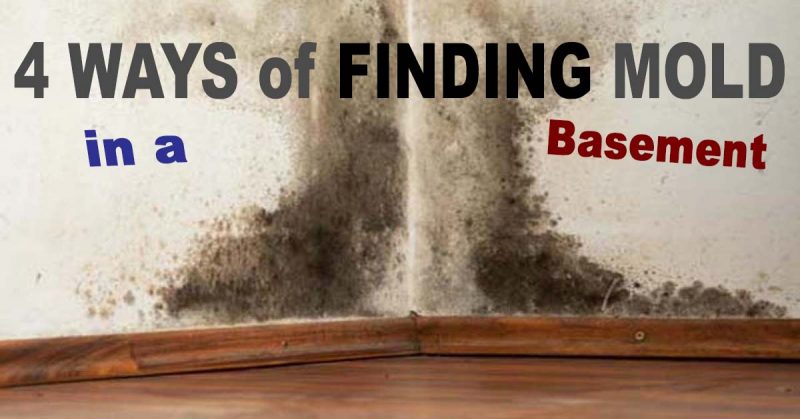4 Ways Of Finding Mold In A Finished Basement
Mold In Basement A Common Problem
One great advantage of purchasing a home with a basement is the benefit of having extra space for holiday decorations, seasonal items and maybe an area for some weights to create a small home gym. However, some people frown on the idea of a basement at all because they can be damp environments that occasionally smell and they fear finding mold in finished basement. Or worse they could have mold but not know how to find mold in the basement. Some will even wonder, “Can mold in basement affect the upstairs?”
Why Most Are Willing To Risk Finding Mold In The Basement – For Extra Space
Most individuals however, are willing to risk potential smells, dampness and even finding mold in the basement for more space. Life has a way of bringing extras into the home you don’t necessarily want to place in a furnished room or next to a refrigerator. These items are better stored in a basement and easily brought upstairs when and if needed. Boxes of important documents, old pictures, sentimental items like completed school projects and babies first shoes and jammies.
Having extra usable space from a basement brings increased homeowner satisfaction due to the greater organization one achieves over contents. Less clutter and more room for decorations and fine furnishings on the main floor can be a tremendous plus, especially as a family grows in the number of children or pets.
The Benefits Of Having A Finished Basement
The greatest advantage to having a basement occurs when it becomes a finished basement. Any property search that finds the added accoutrement of a finished basement will make that property more market valuable; sell quicker and for more money.
Finding or owning a home with a finished basement allows for additional living space for recreation, relaxation and play. Who doesn’t want a nice area for the children to play or an attractive decorated room with seating space equipped with a large screen TV and surround sound? Add a pool table with a well-stocked bar and your home may be nominated by family members for hosting the annual Christmas party. Go one step further and add a home gym with mirrors and exercise equipment and you may become the envy of your neighbors.
Challenges Of Having A Finished Basement
The upside of owning a home with extra space for most will outweigh the fear of finding mold in a finished basement. That is not to say getting mold in a finished basement is not a challenging concern.
Finished basements with all their benefits do present a greater challenge if mold develops because it has multiple areas to hide. Unfinished basements with bad smells will generally be easier to detect mold in because the walls and flooring are not hidden by dry wall and flooring.
Mold can hide behind dry wall, base moldings, paneling and other surfaces like flooring and even cabinets. This can make finding mold difficult and many homeowners have asked for advice on, “how to detect mold inside walls” and “how to get rid of mold in the basement”.
Here are 4 ways of finding mold in a finished basement – without destroying your home.
1. Visual Inspection Of Surfaces.
If you have had basement flooding in the past or noticeable seepage from rod holes or foundation walls you may find mold in your finished basement with an inspection. Mold usually starts with some type of water intrusion that allows moisture to absorb in building materials. Many such materials in a finished basement like dry wall, paneling, wood base moldings and studs are organic and will act as a food source for mold growth. Add several days of these materials being wet and the absence of UV lighting and mold will easily manifest its ugly head.
Look at the base of all dry wall for suspicious spots and on wood base moldings for water stains. If you see alarming black growth or spots of varying colors it is almost certain you have mold. Open doors and look at the door jams to see if there exist water staining. Check all your base moldings to see if they are detached from the walls and a noticeable space is between the base and dry wall. These are additional clues you may have had a water issue that has caused mold.
While evaluating surfaces in the basement don’t overlook flooring that may have water damage. Look for warped planks if you have laminate flooring, or water staining if you have carpet. Your inspection should include taking your hand to the base of any cabinets and slide your hand to see if the cabinet is smooth or feels grated and swollen.
It only takes mold 2-3 days of continued high moisture content before it begins to germinate and reproduce. Eventually the mold source will begin to produce offspring known as mold spores that can travel throughout the basement. Many question, “Can mold in basement affect upstairs” and the unfortunate answer is a resounding yes!
2. Removal Of Damaged Materials.
If you have concerning stains on base of walls and wood base moldings look bad, you need to dig a little deeper. With a utility knife score the top of the base molding that is attached and caulked to the dry wall so it will allow for its removal. Score it from its beginning to its seam where it attaches to another molding. Once one have done this use a pry bar and remove the base from the wall and check the backside for more suspicious spots or black growth. Investigate the dry wall the molding was covering as well for signs of colored growth. If this reveals more suspicious stains, streaks or even films than you have found mold in your finished basement.
For warped laminate flooring it is wise to lift a small section to evaluate the concrete subfloor for moisture or slimy films. The same goes with carpet and/or pad which should be disengaged from a corner and pulled back several feet. If the pine tackles strip is black and the tacks are all rusted than you are finding mold in a finished basement.
3. The Smell Test.
Molds are very efficient at producing, “microbial volatile organic compounds” (mVOCs). These compounds are easier for some to detect than others. As they are released into the air they will manufacture very pungent and unpleasant odors. These are usually the culprits behind that musty and moldy odor some people complain about when they’re in the basement. This smell is a warning just as smoke is when it comes from an ongoing fire. The smell is a result of mold growth in the basement and needs to be found.
The smell test can be an effective tool capable of locating the source of the mold, but will take a little time. Begin by placing your nose as close as you can to any water stained surfaces or suspicious areas of flooring. If you detect a whiff of strong odors often associated with damp clothing you may be finding mold in a finished basement.
Take caution however, on smelling anything that is clearly deemed mold such as colonies of growth on building materials that were not there before. Such staining can be varying colors of black to yellow. It is common sense to assume this to be mold and the last thing you want to do is allow for a breath of mold spores to be introduced into your lungs.
You probably already have been breathing in these spores but in limited amounts. If you have allergies that are becoming aggravated and you were wondering why, asthma. Mold is a very common allergen. If you are suffering from allergies while at home or specifically in your basement, then there is likely hidden mold.
4. Indoor Air Testing
This fourth method is the most important if you want to know how to detect mold inside walls. Air sample testing for mold will also find the dangers of black mold in basement. This method of finding mold in a finished basement will be essential if the first 3 test showed positive for mold in the basement.
Once you find a reputable mold testing firm to test the air in your home it is essential to have not only the basement tested for mold but also the upstairs. Mold in a basement will often affect the upstairs environment by spreading through the furnace system each time the furnace or air conditioning turn on. Such testing will determine what types of mold exist as well as their spore number count.
Based upon the results of the air sample testing a protocol for mold cleanup can be determined by a professional. If your finished basement has mold and you want to know how to get rid of mold in the basement contact the professionals at Action Extraction Inc. We provide free estimates and have affordable strategies to remediate properties after finding mold in a finished basement. Call 800-713-4333 today for a free estimate.
What Next After Mold Is Discovered In A Finished Basement
Finding Mold in a Finished Basement (2)Finding mold in a finished basement is nothing to disregard and left untreated can wreak havoc in a home. If no action is taken than the mold growth will continue, spores will amplify and human health continues to be at risk.
Professional mold removal will tremendously enhance health in those who suffer with allergies if harmful molds are detected such as black mold in a basement. Common symptoms related to finding mold in a finished basement are often completely removed after professional remediation.
Professional Mold Removal
Do-it-yourself mold removal can be affected with non-toxic molds that are in a small area, however it is highly recommended to consult a professional mold removal and remediation firm.
After the mold cleaning process it is important to keep the basement dry and free from unwanted water. Sometimes this will mean water proofing the basement. Any rod holes should be repaired and any wall cracks should be professionally repaired.
If the mold resulted from a sump pump backup be sure to exchange the system every 7 years. If a sewer backup have annual service from a plumber to snake the drain.




